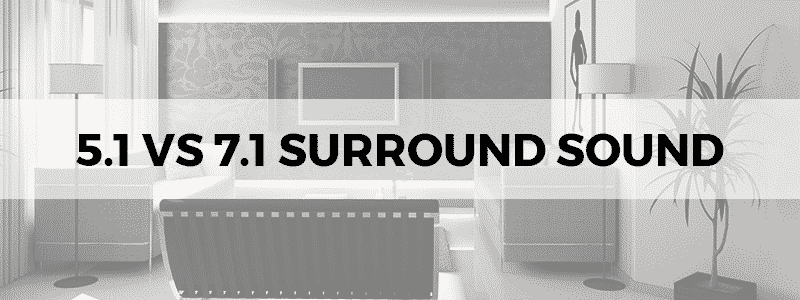
Even as someone who likes to avoid pre-historic clichés like the plague, I find it pertinent to say that the difference between the best home theater speakers and even the best soundbar in a reasonable budget is bigger than an Argentinosaurus.
The secret sauce behind some sound systems sounding more immersive than others is usually chalked up to the usual argument that revolves around 5.1 vs. 7.1.
What exactly does this mean, however, and is the difference really that noticeable?
5.1 vs 7.1 – Surround Sound Explained
Surround sound simply means what the name itself implies; it’s sound that surrounds, as compared to two speakers facing you from each side of your computer screen as the classic home computer system might conjure up images of.
7.1 vs 5.1, then, is mainly a question of channels: 7.1 uses 8 channels and 5.1 uses 6 channels to emit sound.
It’s not so confusing once you realize that the 7.1’s 8 channels are 7 speakers and 1 subwoofer, hence, 7.1 – and the same goes for the 5.1 surround sound system; 5 speakers, 1 subwoofer.
5.1 is your definitive idea of surround sound, whereas 7.1 came to be used nearly 10 years ago, moving from the cinemas to home theaters fairly quickly on the strengths of greater reach in bigger rooms.
In terms of formats, you can differentiate them by name alone, given that 7.1 systems tend to have HD in the name, such as Dolby TrueHD and DTS-HD Master Audio, versus Dolby Digital and DTS for 5.1 sound.
However, saying that 5.1 is the definitive idea of surround sound is more than just a sweeping statement: as of 2019, a little less than 200 Blu-Ray discs worldwide utilized this sound, meaning you wouldn’t hear much difference playing a Blu-Ray mixed to work with 5.1 systems, even if you have literally the most expensive 7.1 system with the best subwoofer in a room designed especially to be a home theater.
Still, most Blu-Ray players are still compatible with 7.1 surround sound, as well as the PS3, PS4, and Xbox One.
5.1, however, is still the industry standard. It’s cheaper and works in most settings, meaning it’s reliably cost-effective.
5.1 vs. 7.1: Usability Difference And Advantages
Comparing 5.1 and 7.1 surround sound is a very delicate decision to make.
The only real decision viz-a-viz 5.1 vs 7.1 is dependent on your room size: a good rule of thumb is to position your main speakers away from the walls, which will help to always allow for dynamic sound design in any room, otherwise the building ‘absorbs’ the sound, for which you’ll be playing around a little and tweaking this once you have your home theater functional, which can help you account for differences in space and room décor in terms of how much sound the room bounces back. In bigger rooms, 7.1 is the best option to get you going.
The price difference isn’t something to sneeze at either, however: even with the differences in different models from different manufacturers, 5.1 surround systems start at around a $100 whereas something like the ‘reasonable’ Onkyo 7.1 can set you back a little less than $300 dollars, with the high-end systems going into multiple thousands of dollars.
As stated previously, most material is mixed for 5.1-channel playback, whether it’s music CDs or Spotify, video games, or almost all Blu-Rays, meaning that with Dolby/DTS decoding, a 5.1-channel receiver and environment will do exactly what you want, rather than just needlessly post-processing something encoded to work just as fine with less money than what you’d spend on a 7.1-channel system.
Setting up Your Surround Sound System For Maximum Results
Place the front center channel, again, just as the name suggests, right in front of your screen, meaning either above or below. Going for the best center channel speaker as per your needs will make up for the difference that the 7.1 provides with the two extra speakers.
Place the subwoofer to either side of, the main/front left and right speakers equidistant from the center speaker at a 30-degree angle, and finally, the surround speakers above 90 degrees from the center channel on each side, left and right.
For a 7.1-channel surround sound system, apply the same rules as for the 5.1-channel setup as far as the common subwoofer and main/front left and right speakers go. For the surround speakers (L/R), placing them at the left and right side viz-a-viz the listening position is ideal, and the rear surround speakers should be about 140 degrees from the front center channel speaker.
It’s a good idea to have the surround speakers just to the sides or elevated above the listening position in both 5.1 and 7.1 surround sound.
Conclusion
In smaller rooms, even virtual sound systems (using a soundbar or a 2.1-channel system) can replicate the feel of a true surround system. Moving into bigger spaces, you inch further towards having a 7.1 surround system, if you’re absolutely nitpicky about how things sound and consider yourself an audiophile.
You can simply, however, get a 5.1 system that supports additional speakers, and if you feel that it absolutely doesn’t cut it for you, get the other speakers and ‘upgrade’. No need to spend all your money and put all your eggs in one basket!
